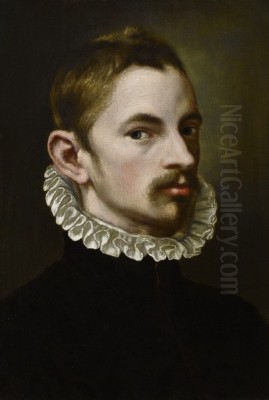
Bartolomeo Passerotti stands as a pivotal figure in the art history of sixteenth-century Italy. Born in Bologna in 1529 and active until his death there in 1592, Passerotti navigated the complex artistic currents of the late Renaissance, absorbing influences from Mannerism, Venetian colorism, and Northern European realism. He forged a distinctive style, excelling particularly in portraiture and pioneering genre scenes, while also producing significant religious works and contributing as a skilled draftsman and etcher. His bustling workshop became a training ground for the next generation, most notably the Carracci, who would spearhead the Baroque revolution. Passerotti was not merely a painter but also a collector and cultural figure, embodying the multifaceted spirit of the late Renaissance artist transitioning towards a new era.
Early Life and Formative Years in Rome
Bartolomeo Passerotti's artistic journey began in his native Bologna, a city with a rich, albeit distinct, artistic tradition compared to the dominant centers of Florence, Rome, and Venice. Seeking broader horizons and advanced training, the young artist traveled to Rome around the mid-1550s. This period was crucial for his development. Rome, the heart of the Papal States and a magnet for artists across Europe, offered unparalleled opportunities for study and exposure.
In Rome, Passerotti entered the orbit of prominent figures. He is documented as having worked with the architect and theorist Giacomo Barozzi da Vignola, a leading exponent of Mannerist classicism in architecture. Perhaps more significantly for his painting career, he assisted Taddeo Zuccari, a highly successful painter known for his large-scale fresco decorations in a sophisticated Mannerist style. Working alongside Zuccari would have immersed Passerotti in the prevailing artistic language of central Italy, characterized by complex compositions, elegant figures, and intellectual refinement, drawing heavily on the legacies of Raphael and Michelangelo.
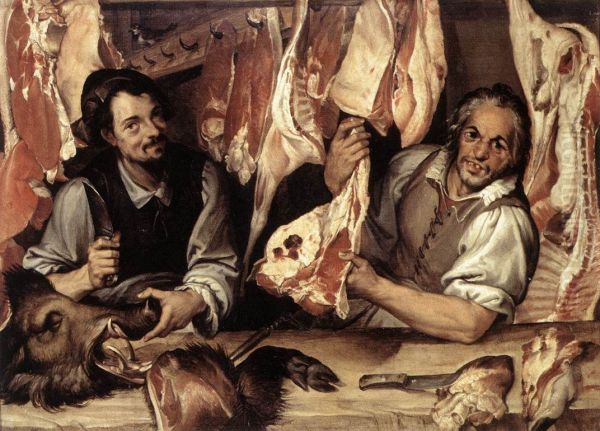
However, Passerotti's Roman experience was not limited to the Zuccari workshop. He actively studied the works of other masters. The influence of Correggio and Parmigianino, Emilian painters celebrated for their graceful figures, soft sfumato, and emotional sensitivity, left a lasting mark on his style. Their work, though rooted in the High Renaissance, possessed a certain elegance and artificiality that resonated with Mannerist sensibilities and clearly appealed to Passerotti. He absorbed their techniques for rendering subtle expressions and delicate textures.
Return to Bologna and the Establishment of a Workshop
Around 1565, Passerotti returned to Bologna, bringing with him the sophisticated skills and diverse influences acquired during his Roman sojourn. He quickly established himself as a leading artist in his hometown, setting up a large and productive workshop. This studio became a central hub of artistic activity in Bologna, attracting numerous pupils and assistants. It was organized to handle a wide range of commissions, from prestigious altarpieces and portraits to the increasingly popular genre scenes.
The workshop was very much a family affair. Passerotti trained his own sons – Ventura (c. 1566–1618), Aurelio (1560–1609), and Tiburzio (c. 1555–1612) – who became painters in their own right, assisting their father and continuing his artistic legacy, albeit without achieving his level of innovation or fame. The presence of his sons and other pupils allowed Passerotti to manage a significant output and disseminate his style effectively within the Bolognese art scene.
Passerotti's return marked a significant moment for Bolognese painting. He injected the local tradition with the Mannerist elegance learned in Rome and the chromatic richness associated with Venice, creating a synthesis that was both sophisticated and accessible. His workshop became a crucial training ground, fostering a new generation of artists who would build upon his foundations.
Artistic Style: A Complex Synthesis
Passerotti's mature style is notable for its eclectic synthesis of various artistic currents. He did not rigidly adhere to a single mode but skillfully blended elements from different schools and traditions, adapting his approach to suit the subject matter and the demands of his patrons. This adaptability is a hallmark of his artistic identity.
At its core, his work often displays Mannerist characteristics inherited from his Roman training, particularly from Taddeo Zuccari. This can be seen in the elongated proportions of some figures, the complex and sometimes artificial poses, and the sophisticated, intricate compositions. He appreciated the elegance and intellectualism inherent in Mannerism.
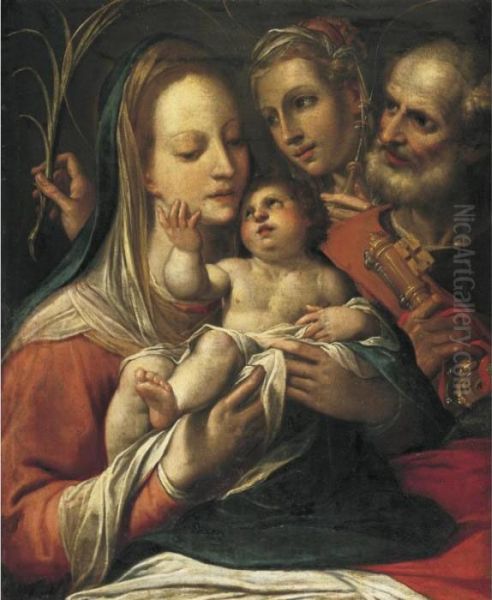
However, Passerotti tempered Mannerist artifice with influences from other sources. He clearly admired the Venetian school's emphasis on color (colorito) and light. While perhaps not directly studying in Venice for an extended period, he absorbed the lessons of masters like Titian, Tintoretto, and Veronese, likely through available works and prints. This Venetian influence is evident in the richer palettes, more atmospheric lighting, and looser brushwork found in many of his paintings, particularly compared to the harder linearity often associated with Central Italian Mannerism.
Furthermore, the grace and sfumato of the Emilian masters Correggio and Parmigianino remained a constant reference point, contributing a softness and emotional appeal to his figures. This connection to his regional artistic heritage provided a counterbalance to the more formal aspects of Roman Mannerism.
Crucially, Passerotti also demonstrated a strong interest in naturalism and direct observation, particularly evident in his portraits and genre scenes. This inclination towards realism connected him to North Italian traditions and, significantly, to Northern European art, particularly the works of Flemish painters like Pieter Aertsen and Joachim Beuckelaer, pioneers of market and kitchen scenes. Passerotti adapted their detailed, often earthy depictions of everyday life for an Italian context. His anatomical studies also reveal a commitment to understanding the human form accurately, underpinning even his more stylized figures.
Master of Portraiture
Passerotti gained considerable renown as a portrait painter, sought after by the Bolognese nobility, clergy, and intellectuals. His portraits are characterized by a keen psychological insight, a meticulous attention to detail in rendering clothing and accessories, and a strong sense of presence. He moved beyond purely idealized representations to capture the individual character and social standing of his sitters.
His approach often combined Mannerist elegance in pose and composition with a Northern European-inspired realism in the depiction of textures and physiognomy. He rendered fabrics, fur, and jewelry with convincing detail, emphasizing the status of his subjects. Yet, he also managed to convey a sense of inner life, capturing subtle expressions and suggesting the sitter's personality. His use of light could be dramatic, highlighting the face and hands against darker backgrounds, a technique that foreshadowed Baroque tendencies.
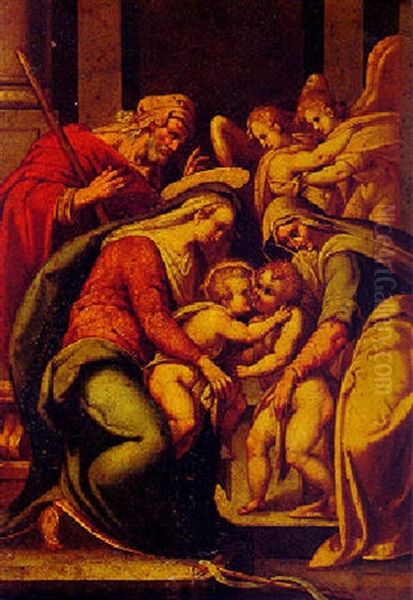
Among his notable sitters were prominent figures of the Church, including Pope Pius V and Pope Gregory XIII (a fellow Bolognese). These papal portraits, along with those of cardinals and bishops, solidified his reputation. He also painted numerous portraits of Bolognese senators, professors, and wealthy merchants, providing a valuable visual record of the city's elite during the late sixteenth century. His ability to balance formal representation with individual characterization made his portraits highly desirable. Compared to the grander, more idealized state portraits by artists like Titian, Passerotti's often feel more direct and intimate, while still conveying authority and dignity, perhaps closer in spirit to the Lombard realism of Giovanni Battista Moroni.
Pioneer of Genre Painting
While accomplished in portraiture and religious art, Passerotti's most innovative contribution arguably lies in the field of genre painting. He was one of the first Italian artists to specialize in lively, detailed depictions of everyday scenes, particularly market stalls and shops. His paintings of butcher shops, fishmongers, and poultry sellers were highly original in the Italian context of the time.
These works drew inspiration from the aforementioned Flemish artists Pieter Aertsen and Joachim Beuckelaer, whose market and kitchen scenes had gained popularity in Northern Europe. Passerotti adapted this genre, infusing it with Italian sensibilities and often a touch of humor or caricature, leading some to classify these works as "pittora comica" (comic pictures). The figures in these scenes – butchers, vendors, customers – are often depicted with robust energy and expressive, sometimes exaggerated, features.
Works like The Butcher's Shop (Galleria Nazionale d'Arte Antica, Rome) or Fishmonger's Shop are celebrated for their vibrant realism and meticulous detail. Passerotti delighted in rendering the textures of meat, fish, and fowl, the gleaming surfaces of metal scales, and the rustic details of the shop interiors. These paintings offer fascinating glimpses into the daily life and commerce of sixteenth-century Bologna. Beyond their documentary value, they showcase Passerotti's skill in complex compositions involving multiple figures, still-life elements, and dynamic interactions. This focus on low-life subjects and realistic detail represented a significant departure from the elevated themes typically favored by Italian Renaissance art and paved the way for later Baroque genre painting.
Religious Commissions
Alongside his portraits and genre scenes, Passerotti maintained a steady production of religious works, including altarpieces and devotional paintings for churches and private patrons in Bologna and the surrounding region. While perhaps less groundbreaking than his genre paintings, his religious works demonstrate his versatility and his ability to integrate different stylistic elements into traditional formats.
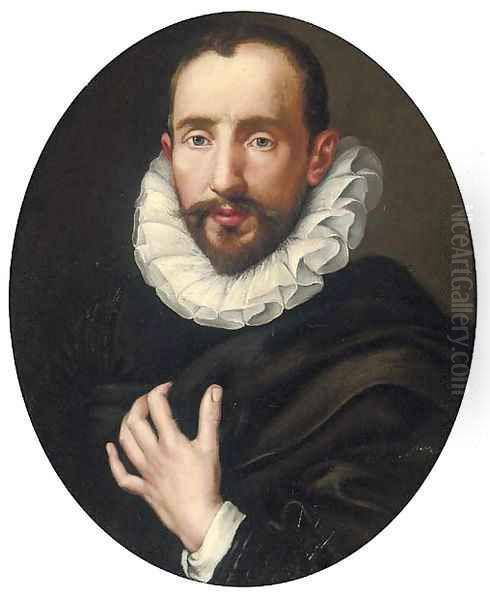
His religious paintings often blend Mannerist compositional structures and elegant figure types with a Venetian-influenced richness of color and a tangible sense of realism in details and settings. Works like The Presentation of Mary in the Temple (1583, Pinacoteca Nazionale di Bologna), painted for the Zambeccari chapel in the church of San Giacomo Maggiore, exemplify his mature religious style. It features a dynamic composition, expressive figures, and careful attention to architectural detail and textures.
In other religious works, such as the Madonna and Child with Saints or scenes from the lives of saints, Passerotti employed his skills in anatomical rendering and dramatic lighting to create emotionally engaging narratives. He sometimes included still-life elements or naturalistic details within these sacred scenes, linking them stylistically to his genre paintings. While adhering to the iconographic conventions of the Counter-Reformation, Passerotti's religious art often possesses a vitality and directness that distinguishes it.
Draftsmanship and Printmaking
Passerotti was a prolific and highly skilled draftsman. Numerous drawings survive, attesting to his working methods and his keen observational skills. These include preparatory studies for paintings, anatomical investigations, portraits, and sketches from life. His drawings often exhibit a vigorous, cross-hatched line, defining form and shadow with energy and precision. His anatomical studies, in particular, reveal a scientific interest in the structure of the human body, reflecting a broader Renaissance concern with understanding nature through direct observation.
He was also an accomplished printmaker, working primarily in etching. His etchings often echo the subjects of his paintings, including religious themes, allegories, and character studies. His printmaking style is characterized by a free and lively line, distinct from the more formal engravings common at the time. Passerotti often signed his etchings with a rebus incorporating a sparrow ('passero' in Italian), a playful nod to his surname. His prints helped to disseminate his compositions and style to a wider audience.
The Collector and Cultural Figure
Beyond his artistic practice, Passerotti was a significant figure in Bologna's cultural life. He was an avid collector of art and antiquities, assembling a personal 'museum' that was renowned in his time. This collection reportedly included ancient Roman sculptures, cameos, coins, medals, paintings, drawings, and natural curiosities like preserved animals and minerals.
Establishing such a collection was characteristic of the Renaissance humanist spirit, reflecting a desire to study and preserve the legacy of antiquity and the wonders of the natural world. Passerotti's museum was not merely a private hoard; it functioned as a place of study and inspiration, likely used in the training of his pupils and accessible to interested visitors and scholars. It was considered one of the early private museums in Bologna and contributed to the city's reputation as a center of learning and culture. After his death, the collection was maintained and possibly expanded by his sons, remaining a point of interest in Bologna. This role as a collector highlights Passerotti's intellectual curiosity and his engagement with the broader cultural currents of his era.
Legacy and Influence: Paving the Way for the Baroque
Bartolomeo Passerotti's most enduring legacy lies in his influence on the subsequent generation of Bolognese artists, particularly the Carracci family – Ludovico, Agostino, and Annibale. Annibale Carracci, arguably the most talented and influential of the three, is known to have spent time in Passerotti's workshop, although the exact nature and duration of his training there remain debated.
Regardless of the formal pupil-teacher relationship, Passerotti's art provided a crucial local precedent for the Carracci reform. His emphasis on drawing from life, his interest in naturalism (especially in portraiture and genre scenes), his study of anatomy, and his absorption of Venetian colorism all prefigured key elements of the Carracci's artistic program. Their famous Accademia degli Incamminati (Academy of the Progressives), founded around 1582, promoted a return to nature and the study of High Renaissance and Venetian masters as an antidote to the perceived excesses and artificiality of late Mannerism.
Passerotti's pioneering genre scenes, like the butcher shops, directly inspired Annibale Carracci's own early works in this vein, such as his famous Bean Eater or his own Butcher's Shop. Passerotti's robust realism and focus on everyday subjects provided a foundation upon which Annibale could build his more profound and psychologically penetrating explorations of common life. Furthermore, Passerotti's integration of Venetian color and light offered a model for moving beyond the drier palettes sometimes associated with Central Italian painting.
While the Carracci ultimately forged their own distinct path, leading the way towards the dynamic naturalism and emotional intensity of the Baroque, Passerotti's role as a precursor was vital. He helped to revitalize the Bolognese school, creating an environment where a synthesis of naturalism, classical tradition, and rich painterly effects could flourish. His work represents a crucial bridge between the sophisticated artifice of late Mannerism and the emerging concerns of the Baroque era. He stands apart from the starker realism that Caravaggio would soon champion in Rome, offering instead a North Italian pathway towards naturalism, enriched by color and a certain earthy vitality.
Conclusion: An Artist of Transition
Bartolomeo Passerotti occupies a significant place in the narrative of Italian art. Active during a period of stylistic transition, he skillfully navigated the complex artistic landscape of the late sixteenth century. Rooted in the Mannerist tradition through his Roman training with figures like Taddeo Zuccari, he enriched his style with the chromatic lessons of Venice and the graceful models of Correggio and Parmigianino. His sharp eye for observation led him to excel in portraiture, capturing the likenesses of popes and local dignitaries with psychological acuity and realistic detail.
Perhaps most importantly, his innovative genre scenes, inspired by Northern European precedents like those of Pieter Aertsen but imbued with Italian verve, broke new ground and directly influenced the revolutionary Carracci brothers, particularly Annibale. As a teacher running a large workshop, a skilled draftsman and etcher, and an avid collector, Passerotti was a central figure in the artistic and cultural life of Bologna. He represents more than just a talented provincial master; he was a key transitional figure whose work synthesized diverse influences and helped lay the groundwork for the emergence of Baroque painting in Italy. His art provides a fascinating window into the vibrant world of late Renaissance Bologna and its pivotal role in shaping the future course of European art.